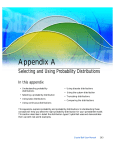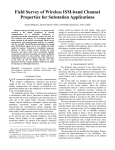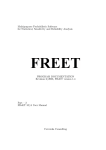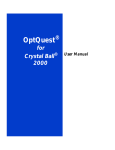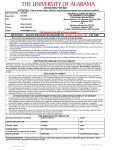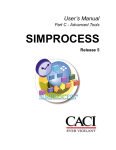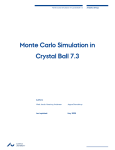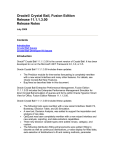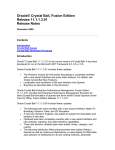Download What`s New in Oracle® Crystal Ball? What`s New in Version
Transcript
What’s New in Oracle® Crystal Ball? Browse to: - What’s new in version 11.1.1.0.00 - What’s new in version 7.3 - What’s new in version 7.2 - What’s new in version 7.1 - What’s new in version 7.0 - What’s New in Version 11.1.1.0.00 Version 11.1.1.0.00, released in summer 2008, is available in English only. Starting with this release, a new version numbering scheme has been implemented with additional digit groups in order to align with Oracle versioning standards. This version of Crystal Ball includes: Updated OptQuest Optimization Feature The OptQuest optimization feature has been completely rewritten for this version of Crystal Ball. The new version of OptQuest includes: - A new Wizard for setting up optimizations. - Full integration with Excel and Crystal Ball, including the ability to control optimizations through Crystal Ball’s control panel. - An updated version of OptQuest’s world-class global optimization engine: o Support for both linear and non-linear constraints o More aggressive algorithm o New variable types: binary, category, and custom - Ability to create reports and extract data. - A Developer’s Kit (API) for programming optimizations. What’s New in Oracle® Crystal Ball? 2 Location Parameter for Lognormal Distribution The lognormal distribution now has a new location parameter to help you model shifted lognormal distributions. This three-parameter distribution is available for setting up assumptions and for fitting to datasets. Parameter Locking for Certain Distributions You can now lock the values of certain parameters of selected distributions while fitting data to those distributions. The following parameters can be locked in this release: - Location of lognormal - Location and shape of gamma - Location and shape of Weibull 3 What’s New in Oracle® Crystal Ball? - Degrees of freedom for Student’s t - Trials for binomial - Trials for hypergeometric New Discrete Distribution Fitting Distribution fitting now includes discrete as well as continuous distributions and certain parameters can be locked for increased accuracy. You can fit all discrete distributions supported by Crystal Ball, except the Yes-No distribution, to integer data sets. For discrete fitting, you can view the Chi-square statistic and Chi-square p-values. Anderson-Darling and Kolmogorov-Smirnov statistics are not currently available for discrete fitting. P-Value Calculations When fitting to continuous distributions, P-Value calculations for Anderson-Darling and KolmogorovSmirnov have been added for the following distributions: - Normal - Exponential - Minimum Extreme - Maximum Extreme - Logistic - Uniform - Gamma - Weibull - Lognormal A New Wizard Format for Crystal Ball Tools The following Crystal Ball Tools have been rewritten with a wizard format for increased ease of use: Batch Fit, Bootstrap, Decision Table, and 2D Simulation. What’s New in Oracle® Crystal Ball? 4 New Data Analysis Tool A new tool, Data Analysis, helps you import data directly into Crystal Ball forecasts, one for each data series. Then, you can analyze it using any of Crystal Ball’s charting, reporting, and data extraction features. Crystal Ball Licensing Enhancements You can now use Crystal Ball in evaluation mode for a limited time, usually 30 days, without needing to activate a license. License activation no longer requires an Internet connection with an online licensing server. These enhancements were designed to streamline the installation and licensing procedure. 5 What’s New in Oracle® Crystal Ball? What’s New in Version 7.3 Version 7.3, released in April 2007, adds new features and capabilities. Crystal Ball version 7.3 is available in English only. Crystal Ball 7.3 includes: Support for Microsoft® Excel® 2007 and Windows Vista™ Crystal Ball 7.3 is the first release of the software officially supported on both Microsoft Office 2007 and Windows Vista. Crystal Ball 7.3 now includes a new Office 2007 ribbon for easy access to the Crystal Ball tools and features. Users will be able to benefit from the new capabilities found in Excel 2007. Now you can take advantage of all the new Excel features in Office 2007 to create better spreadsheets, improve spreadsheet analysis, share spreadsheets and business information with others and manage business information more effectively. Browse to the Microsoft Office Excel 2007 product overview for more information. Some of the many new Excel features include: ability to have up to 1 million rows by 16,000 columns in your spreadsheets, a completely redesigned charting engine, greatly improved support for tables, advanced conditional formatting to more easily discover patterns and trends and much more. Scatter Charts Crystal Ball 7.3 offers users the ability to create scatter charts, which display one set of numerical data along the x-axis and another along the y-axis. Scatter charts display correlations, dependencies, and other relationships between pairs of forecasts and assumptions plotted against each other. This additional investigative tool provides a visual way to make more informed decisions. The betaPERT distribution The betaPERT distribution describes a situation where you know the minimum, maximum, and most likely values to occur. This distribution is popular among project managers for estimating task durations and the overall length of a project. What’s New in Oracle® Crystal Ball? 6 Ability to load and unload Crystal Ball after Excel has started After Microsoft Excel has started, users can now open and close Crystal Ball manually or automatically, depending on their preferences. You can do this either manually through the COM Addins menu to Excel, or use new Developer Kit calls (available with Crystal Ball Professional and Premium Editions) to load and unload Crystal Ball while Excel is open. Distribution fitting enhancements Fitting routines have been changed for some distributions (gamma, lognormal, Weibull and Student's t) to calculate better distribution parameters for a range of datapoints within a reasonable time. These changes might affect the fitting results for your data. The new routines have been tested and give results that are close to the previous results and compare favorably with Minitab and Matlab, among other applications. 7 What’s New in Oracle® Crystal Ball? What’s New in Version 7.2 Version 7.2, released in November 2005, adds many new and useful features to the software. These can be grouped in three main categories: Process Capability features that support quality improvement methodologies such as Six Sigma DFSS (Design for Six sigma) and Lean principles. Ease-of-use enhancements, including a Welcome screen with links to tutorials and models, split view charting, and dual locking grabbers. Performance improvements such as faster response for Correlation Tool, faster response for models with large numbers of assumption and forecasts, and support for circular references in Extreme Speed. Welcome Screen For the first time, Crystal Ball provides a Welcome screen for beginner users. With links to tutorials, tips and techniques, plus one-click icons, this screen helps you to start using Crystal Ball right away. New users no longer open Crystal Ball to a blank spreadsheet! The screen will also help you to access an Examples Guide with over 39 different Crystal Ball example models from a cross section of industries and applications. Process Capability Features Version 7.2 introduces a new set of process capability features specifically geared towards our many users in quality improvement fields such as Six Sigma, DFSS (Design for Six Sigma) and Lean principles. Process Capability Guide The new Crystal Ball Process Capability Guide introduces the process capability features and suggests ways to interpret and apply them. Please consult the Process Capability Guide for more detailed information. The Guide includes: • • • Tutorial 1: Improving Process Quality Tutorial 2: Improving Design Quality Lean and other examples What’s New in Oracle® Crystal Ball? • 8 Definitions of capability metrics calculated by Crystal Ball and how to activate and use them Models Version 7.2 also includes ten quality-related models. Define Forecast Now includes the ability to define specification limits (LSL, USL and Target) in the Define Forecast Dialog Capability Options These options help you define: • Whether to use short- or long-term metrics • The shift value between metrics • How metrics should be calculated and how to calculate if the normality test fails. Capability Metrics Along with the standard descriptive statistics, Crystal Ball now provides capability metrics 9 What’s New in Oracle® Crystal Ball? based on the simulation results. Now you can quickly verify not only which inputs have the greatest effect on variation (with sensitivity charts), but also the important metrics that describe the quality of the process or product, including whether or not the process is normal. Capability Metrics and OptQuest® In addition to the descriptive statistics, you can also define an objective or a requirement in OptQuest using Cp, Cpk, Zst, Slt, Ppm and Cpm as a forecast statistic (Professional or Premium Editions only). Split View Forecast Charts with Capability Metrics With split view, you can clearly display your simulation results through a combination of tables and graphs in a single window. Split View Forecast Charts Split view lets you view multiple forecast charts and statistics in the same window. You can view: Frequency, Cumulative Frequency, Reverse Cumulative Frequency, Statistics, Percentiles and Capability Metrics at the same time (or any combination thereof). What’s New in Oracle® Crystal Ball? 10 What’s New in Version 7.1 Version 7.1, released in March 2005, added Extreme Speed to Crystal Ball Professional and Premium Editions. Extreme Speed With unprecedented speed in spreadsheet simulation and optimization, Crystal Ball 7 (version 7.1) quickly solves almost any problem where uncertainty and variability distort spreadsheet forecasts. Crystal Ball 7 extends the ability of the software with a dramatic increase in simulation speed - up to 100 times faster than normal. From the Run Preferences menu, simply select the Extreme speed mode to run your simulations much faster than normal. So fast, in fact, we put in a Demo speed mode, which runs simulations in "slow-motion" to make it easier to watch values change in spreadsheet cells and charts. Great for presentations or for teaching! Normal and Demo speed are available in all three Crystal Ball Editions. Extreme Speed is available in the Professional and Premium Editions. Language compatibility Crystal Ball 7 (version 7.1) is compatible with both English and non-English versions of Microsoft Windows and Office. 11 What’s New in Oracle® Crystal Ball? What’s New in Version 7.0 Version 7.0, released in September 2004, adds many new features to the software. These can be grouped in three main sections: 1. Faster time to results. 2. Enterprise-wide enhanced collaboration and standardization. 3. Better communication of results. Charting A new charting engine delivers amazing presentation-quality charts and reports. Charts also support 3D views and right-click menus. Distribution Gallery Distribution Gallery dialog, which now sports an Outlook-like interface, groups the distributions into folders called Categories. Categories are libraries of distributions. The Distribution Gallery, by default, consists of 3 categories: All, Basic and Favorites. The All category comprises all 21 available Crystal Ball distributions. The Basic category comprises the 6 most commonly used distributions. The Favorites category is empty by default. This category is provided for you to store your favorite or most commonly used distributions, for quick reference. What’s New in Oracle® Crystal Ball? 12 User-Defined Categories and Distributions You can also create your own categories, and populate them with Crystal Ball-provided distribution, or with user-defined (or pre-defined) distributions. In this example, you create a new category called Stress Parms, in which you save all the distributions that you want to use with your Helical Spring model. Categories can be populated directly from the Define Assumption dialog, or by copying a distribution from another category and then modifying it if needed. By saving your user-defined distributions, you can re-use them again in other models. You can also modify the distribution's description, so that anyone reading it will know what its purpose is. 13 What’s New in Oracle® Crystal Ball? Publish and Subscribe Expanding on the concept of one person defining a distribution once and using it many times, Crystal Ball 7 introduces the ability to publish many categories and subscribe to categories. Define a distribution once, publish it, and allow multiple people to subscribe and use it many times. Custom Distribution It is now possible to link directly to data in the spreadsheet. There is also a new data grid to manipulate data from within the assumption editor. Control Panel The Control Panel is a new feature in Crystal Ball 7. It gives the user a direct interface to control simulations, instead of using the menu or toolbar. What’s New in Oracle® Crystal Ball? 14 Reports Select a pre-defined report or create your own custom report. Reports now include new statistics and more control over data and charts. 15 What’s New in Oracle® Crystal Ball? Preferences • Chart preferences are now in their own, independent dialog. • Expanded forecast preferences include preferences for the forecast window, precision, filter and auto-extract. • New assumption preferences. Extract Data You can extract data from both forecasts and assumptions and extract multiple types of data. What’s New in Oracle® Crystal Ball? Auto Extract Crystal Ball 7 now includes an auto-extract feature that writes selected forecast information and statistics to an Excel worksheet after simulation. 16 17 What’s New in Oracle® Crystal Ball? Assumptions The new assumption chart interface allows you to add marker lines to track specific values or statistics, and graphically view the generated random numbers. The randomly generated assumption values are now saved automatically as a run preference. Forecasts • Add the ability to fit distributions to forecasts during simulation. • Include many different custom marker lines on forecasts (mean, median, standard deviations, base case, percentiles, etc.). What’s New in Oracle® Crystal Ball? 18 Sensitivity Analysis (sensitivity chart) New charting capabilities and an enhanced data view. Distribution Fitting It is now possible to show distribution fitting while running a simulation. There is also an enhanced data view for quick access to fit statistics. 19 What’s New in Oracle® Crystal Ball? Overlay Chart Fit distributions to all forecasts. View stats and percentiles for all forecasts. New charting including transparent and 3D viewing plus rotation. Correlated Assumptions Correlations have an enhanced data picker for adding assumptions. In addition, correlated assumptions can now span worksheets. What’s New in Oracle® Crystal Ball? Choosing Objects A new chooser allows you to easily pick which charts to show (assumptions, forecasts, overlay, trend and sensitivity), as well as select some or all of your assumption, forecast and decision variable cells from your spreadsheet. You can change the display from a Tree view to a List view. 20 21 What’s New in Oracle® Crystal Ball? Online Help documentation Online help is enabled via the F1 key, Help buttons, and Help menus in charts. You can also access online help by choosing Help > Crystal Ball > Crystal Ball Help in the main menu bar in Excel. User Macros The macro scheme is different in Crystal Ball 7. There is no longer a Macro “Preference tab”. Rather, Crystal Ball 7 searches for macros of a certain name and executes them accordingly. This new scheme gives users more flexibility in testing and maintaining run-time macros. You can also run Crystal Ball macros in protected spreadsheets by unlocking them via an encrypted Dev Kit call. What’s New in Oracle® Crystal Ball? 22 Save/Restore Results Save/Restore enables users to save parts of the simulation data for later retrieval. Results are no longer “attached” to the spreadsheet so it is possible to restore multiple results at the same time. This also makes it possible to share the results without having to share the underlying model. New Probability Distributions Crystal Ball 7 introduces new probability distributions: • Student's t • Discrete Uniform • Maximum and Minimum Extreme (created by splitting the Extreme distribution) • Yes-No The Beta and Hypergeometric distributions have parameter changes. Some custom distribution formats, such as five-column single values, are no longer supported. See the notes in the Custom Distribution section at the end of Appendix A of the Crystal Ball User Manual. Distribution Parameters • Enter cell references for parameters by directly clicking on the spreadsheet cell. • Enter complete formulas for parameters in place of simple values. • Change the shapes of probability distribution easily by using spinner controls to tweak the parameters. Crystal Ball is a registered trademark of Oracle. OptQuest is a registered trademark of OptTek, Inc. is a trademark of Frontline Systems, Inc. Microsoft and Windows Vista are either registered trademarks or trademarks of Microsoft Corporation in the U.S. and other countries. All other trademarks are the property of their respective owners. All rights reserved. Oracle and Crystal Ball are registered trademarks of Oracle Corporation and/or its affiliates. Other names may be trademarks of their respective owners.






















